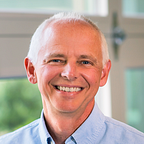The Future is Ours to Choose
Hopefully, despite the devastating march of COVID-19, you’ve taken some time to walk around your neighborhood. If you have, some things might have caught you off guard — for example, my NYC-based colleague told me this is the first time she’s heard birds chirping outside her apartment. And across the country, you’ve probably noticed the wonderful air quality we all have right now. It feels good to breathe less polluted air.
When we started Tesla Motors in 2003, this kind of air quality was one of our goals. Actually, our vision was of even cleaner air, because depending on where you live, what we’re seeing now is the result of a 30–70% drop in miles driven by internal combustion vehicles. But if we achieve the long-term goal of electrifying all cars and light trucks — closer to a 100% drop — we’ll enjoy clear skies and healthy air all the time, for all time.
Right now, we’re seeing a glimpse of a possible future which, normally, seems far-off and imaginary. Clean air like this is possible: all we have to do is electrify cars. As a bonus, we’d be building a world of cars with epic acceleration, which is great fun.
This future is possible, but it’s not inevitable. It’s on us to actively build the future the way we want it to be.
History has shown that terrible events like COVID-19 can open up opportunities to rebuild differently, to imagine different futures, and to make social and cultural changes that would have seemed impossible before. We’ve made small and large changes many times before.
After the 1918 Pandemic
Until 1918, spittoons were commonplace in daily American life. They could be found in hotel lobbies, courthouses, pubs, restaurants, train stations, and any public space where people (well, men, really) couldn’t acceptably spit on the floor. Sidewalks were especially fine targets for spitting, but inside, gentlemen needed a spittoon.
Then, in 1918, spitting was identified as one of the ways the flu was spreading.
Someone had the idea of changing people’s behavior in order to improve everyone’s health, and one of the first public health campaigns was launched. Spittoons were rounded up, and after the pandemic passed, they didn’t reappear. Social expectations had changed, and spitting was no longer expected. Companies jumped in to help too, pushing chewing gum and the more “hygienic” cigarettes in place of chewing tobacco. Although we could have done without cigarettes, I don’t think anyone misses spittoons. Plus, adding the idea of public health was a great win.
The phase-out of spittoons is one illustration of how a catastrophe can create a permanent, positive change in our behavior. In this particular case, it was relatively easy, because the urgency was obvious and the connection was direct.
But, more sophisticated things can happen, too.
After WWII
Consider the well-known example of what happened in the workforce during and after WWII. As women were recruited to fill the many wartime jobs that had belonged to men, many found they rather enjoyed the “men’s work” that had always been closed to them. Thanks in part to that glimpse of a different, possible future, activists worked hard to make that change permanent.
After a visit to the Rosie the Riveter Museum in Richmond, California, I learned that the emergency employment change was eye-opening not only for women, but also for members of the African-American and nascent LGBTQ communities. It allowed them to imagine a better future world in which they played a full part, although obviously, those struggles have taken decades and continue to this day.
After COVID-19
COVID-19, like these other big upheavals, has shown us glimpses of alternative futures — some decidedly dystopian, others rather interesting. This interruption of our status quo has caused many of us to reconsider what actually is important.
For me, being trapped in perpetual WFH-mode has given me an entirely new appreciation for my remote partners at Spero. It’s making me consider how we can create a more genuine human connection through the remote experience. The lack of traffic makes me consider what other work, transportation and life changes we might want to make. And, of course, the fantastic air quality is reminding me of why EVs are so important.
What things from this time do you want to keep?
We will defeat COVID-19 by our collective action combined with the cutting-edge science of new treatments and vaccines, likely in record time. We may choose to keep some of our new habits long after this crisis recedes, either because we’ve discovered we kind of like them, or because we believe they will help us weather or prevent the next crisis.
The future I imagine is one of sustainable abundance.
The future I imagine is one of sustainable abundance. It’s one in which we’re able to meet all the nutritional and material needs and desires of our society without compromising the ability of future generations to enjoy those same benefits, or wiping out the rich biodiversity of our planet along the way. I imagine a society filled with purpose that can continue, can be sustained, indefinitely. At the moment, we are a long way from that future, but we all make the future happen.
At Spero Ventures, we invest in technology companies that make life worth living. They fall into three categories: Health & Wellness for people and our planet, Work & Purpose, and Human Connection. If you are an entrepreneur building a future we all want to live in, please reach out to us.
